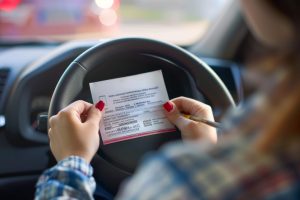In Ontario, getting a motorcycle license involves a step-by-step process to ensure riders are ready for the road. It starts with the Class M1 road test, which assesses basic knowledge of motorcycle riding and road rules. This guide will explain the class M road test, how to prepare for it, and what to expect as you work toward your full motorcycle license.
What is a Class M1 Road Test?
The Class M1 road test is the first step in obtaining a full motorcycle license, part of the graduated licensing system. When you pass the written knowledge test, you are granted an M1 license, which allows you to practice riding with certain restrictions, such as only riding during daylight hours and avoiding highways with speeds over 80 km/h.
Class M1 Road Test Components
The M1 test is a written exam that checks your basic knowledge of motorcycle riding, road rules, and traffic signs in Ontario, Canada. It has 40 multiple-choice questions, all taken from the official M1 rider’s handbook, with only one correct answer for each question. To pass, you need to get at least 32 questions right.
If you pass, you must wait at least 60 days before taking your first road test. Your M1 license is valid for 90 days, so be sure to book your road test before it expires, or you’ll need to start the process again.
Class M1 Road Test Requirements
To apply for a motorcycle license in Ontario, you must meet the following conditions:
- Written test: This test checks your understanding of traffic signs, road rules, and motorcycle-specific regulations. It covers essential knowledge like how to recognize road signs and signals, and how to follow the rules of the road as a motorcyclist.
- Age requirement: You need to be at least 16 years old to be eligible.
- Vision test: You’ll have to take a vision test to ensure your eyesight is good enough to ride safely.
What Happens If You Fail The Test?
If you fail the M1 written test on your first try, you’ll need to retake the test, which means you won’t be able to get your M2 license as planned. Normally, you can get an M2 license after riding with an M1 for 60 days.
This phase is meant to help you build confidence and skill before moving on to the next level of your motorcycle license (M2).
What is the Class M2 Road Test?
The Class M2 road test is the second step in Ontario’s graduated motorcycle licensing system. This test assesses your ability to handle a motorcycle in real-world conditions, focusing on essential skills like starting, stopping, turning, and navigating through traffic.
Passing the M2 road test upgrades your license to an M2, allowing you to ride at night, on any road, and with a passenger. However, you’ll still need to maintain a zero blood-alcohol level while riding. You can choose to take the test on your own motorcycle or opt for an MTO-approved motorcycle safety course, which provides more in-depth training and a smoother path to success.
Class M2 Road Test Requirements
Before taking the Class M2 road test in Ontario, it’s important to be aware of the requirements to ensure a smooth testing process.
- Age Requirements: To apply for a motorcycle license and take the M2 road test, you must be at least 16 years old.
- M1 License: A valid M1 license is required to be eligible for the M2 road test.
- Identification: Bring a government-issued ID that shows your legal name, date of birth, and signature. Acceptable forms of ID include a passport or Ontario Photo Card.
- Proof of Course Completion: If you’re taking the test through an MTO-approved motorcycle safety course, be sure to bring proof of course completion. Some training organizations provide a referral envelope or electronic confirmation that you’ll need to present on test day.
Explanation of the M2 Test Layout
The test takes place on public roads, where you’ll be assessed on your ability to handle everyday riding situations, such as navigating traffic, making turns, and passing through intersections. The goal is to ensure you’re prepared to safely ride in a variety of conditions.
Basic Skills Required for M2
Below are the key areas the examiner will focus on to assess your overall riding competence:
- Maneuvering: You’ll need to show that you can control your motorcycle through tight turns, lane changes, and safely merging into traffic.
- Balancing: Maintaining balance is crucial, whether you’re starting, stopping, or riding through turns. You’ll be assessed on how well you handle your bike at different speeds without losing control.
- Stopping: The ability to come to a safe, controlled stop is essential. You’ll need to show you can stop at traffic lights, stop signs, and in unexpected situations.
- Signaling: Proper use of turn signals and hand signals is key to communicating with other road users. You’ll be evaluated on how well you signal before turns, lane changes, and stops.
Practical M2 Test Details
During the exam, an examiner will follow you, often in a car, to observe how you handle your motorcycle in traffic. You’ll be evaluated on your understanding of traffic laws, safe riding practices, and road awareness. The test covers a range of riding environments, including intersections, lane positioning, and potentially both urban and suburban roads. If you pass, your M2 license will be mailed to you.
What is a Full Class M License?
A Full Class M license in Ontario is the final step in the graduated motorcycle licensing system, granting riders full, unrestricted privileges. To qualify, you must hold your M2 license for at least 22 months, or 18 months if you’ve completed an approved safety course. After passing the M2 exit test, restrictions like the zero blood-alcohol rule and highway limits are removed. The Full Class M license provides lifetime riding privileges in Ontario without expiration.
Class M Road Test Requirements
To take the Class M road test in Ontario, you must have held an M2 license for at least 22 months, or 18 months if you’ve completed a Ministry-approved motorcycle safety course. On test day, you’ll need to bring your valid M2 license, proof of insurance, and a street-legal motorcycle. Don’t forget to wear proper riding gear, including an approved helmet. The test is typically held at a DriveTest center and may require scheduling in advance.
Full M Test Procedures and Layout
The Class M road test assesses your ability to handle a motorcycle in real-world conditions on public roads. You’ll ride through different environments, including residential streets, highways, and urban areas. Key skills tested include lane changes, intersection turns, proper signaling, recognizing road signs, and following traffic rules. The test usually lasts 20 to 30 minutes.
Riding Safely in Traffic and Urban Areas
A major part of the full Class M test involves riding in busy urban areas. You’ll be assessed on your ability to navigate traffic safely, maintain following distances, manage blind spots, and respond to unpredictable situations like pedestrians or sudden stops. Proper lane positioning, turning, and stopping in congested areas are also closely monitored.
Final Words
Becoming a safe and skilled motorcyclist is a journey that blends excitement with responsibility. Begin with proper training, invest in quality protective gear, and practice regularly to hone your skills. Stay alert on the road, maintain your motorcycle diligently, and commit to continuous learning to fully enjoy the freedom of riding while minimizing risks.
The Class M1 license is the first step in Ontario’s motorcycle licensing system, with restrictions like no highway riding, no passengers, and only riding during daylight. After passing the M1 exit test, you get a Class M2 license, which removes most restrictions.
Technically, you can take the M2 road test without formal motorcycle experience if you have an M1 license. However, it is highly recommended to take an approved motorcycle safety course, as these courses provide hands-on training and greatly increase the chances of passing the test.
The Class M road test typically takes between 20 and 30 minutes. It involves real-world riding situations where examiners assess your skills in various traffic conditions, including higher-speed roads, urban settings, and complex maneuvers.
If you fail the Class M or M2 road test, you can retake it after a designated waiting period. There are no penalties beyond having to wait for a retest, though you may need to pay the test fee again. It’s advisable to take extra practice or attend a refresher course before attempting the test again.
There are no exemptions for the M or M2 road tests in most cases. However, if you have a valid motorcycle license from another jurisdiction, you may be able to bypass some stages of the graduated licensing process depending on your prior experience.
If you fail the Class M or M2 road test, you can typically retake the test after a mandatory waiting period of 10 days. This waiting period allows time for additional practice before retesting, and you’ll need to pay the test fee again when rescheduling.





